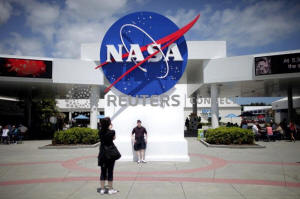NASA eyeing inflatable space lodges for moon, Mars and beyond
 Send a link to a friend
Send a link to a friend
 [October 17, 2019]
By Joey Roulette [October 17, 2019]
By Joey Roulette
LAS VEGAS (Reuters) - When astronauts orbit
the moon or live on its surface in the decade ahead, they will probably
be doing so inside inflatable space lodges now in development.
Dozens of NASA officials and veteran astronauts are wrapping up a review
of five space habitat mockups built by different companies. The mockups
offer the U.S. space agency ideas for an ideal Gateway - the planned
research outpost in lunar orbit that will house and transfer astronauts
to the surface of the moon.
“The whole point is to define what we like and what we don’t like about
these different habitats,” NASA astronaut Mike Gernhardt, principal
investigator for the testing campaign, told Reuters.
He and his team were making a final inspection recently in Las Vegas,
Nevada at the headquarters of Bigelow Aerospace, a space habitat company
founded by hotel chain billionaire Robert Bigelow.
U.S. Vice President Mike Pence in March told NASA to land its first crew
of astronauts on the moon by 2024. That accelerated timeline spawned the
space agency’s Artemis program, which calls for privately built lunar
landers, robotic rovers and Lunar Gateway — a modular space station in
orbit around the Moon with living quarters for astronauts, a lab for
science and ports for visiting spacecraft."Gateway is an opportunity to
test all these structures in a deep space environment... as a prelude to
going to Mars," Bigelow told reporters. "Potentially we think that for
the rest of this century, the expandable architecture is where it's at."
Bigelow's B330 habitat, launched from Earth compacted inside a rocket,
is made of a fabric-like material designed to shield inhabitants from
deep-space radiation and high-speed space debris. Once docked alongside
other Gateway modules in lunar orbit, the habitat unfurls into a
two-story, 55-foot-long (16-meter-long) outpost that up to six
astronauts could stay in.
The lunar space habitat and colonization program is expected to cost
over a billion dollars through 2028.

TOILETS, BEDS AND WINDOWS
Four other companies are doing mockups: Boeing Co, Northrop Grumman,
Sierra Nevada Corporation, and Lockheed Martin.
[to top of second column]
|

Tourists take pictures of a NASA sign at the Kennedy Space Center
visitors complex in Cape Canaveral, Florida April 14, 2010.
REUTERS/Carlos Barria

Each of the companies received a chunk of the $65 million that NASA
allotted in 2017 to develop the prototypes. The space agency’s
proposed funding for 2020 includes $500 million to kickstart
development of an initial version of Gateway.
The companies are giving NASA ideas — such as where to place
astronaut toilets, how big the beds should be and how many windows
the station should have. Those will inform a blueprint that NASA is
due to release in the coming months.

NASA wants the habitats to include exercise equipment, a small
kitchen, noise-cancelling sleep stations that also block out light
and “a reliable and easy-to-use toilet that’s in a location that
minimizes the potential for cross contamination with science and
meal preparation activities,” Gernhardt told Reuters.
Gernhardt and two other astronauts spent three days living in each
prototype habitat.
For its Gateway habitat mockup, Lockheed Martin is outfitting beds,
tables and windows in a 15-foot-wide and roughly 22-foot-long
stainless steel structure originally designed as a shipping
container to carry supplies to and from the International Space
Station.
"The space that you’re living in has to be reconfigurable for the
task at hand,” Bill Pratt, Lockheed’s habitat program manager, told
Reuters. “Like in an RV, your table becomes the bed that you sleep
on at night.”
Bigelow said his B330 habitat has two toilets for a crew of up to
six to use, and that entertainment in the form of virtual-reality
Earth simulations for astronauts to feel at home was in the works
for future habitats that will revolve around Mars.
(Reporting by Joey Roulette; editing by Bill Tarrant and Cynthia
Osterman)
[© 2019 Thomson Reuters. All rights
reserved.]
Copyright 2019 Reuters. All rights reserved. This material may not be published,
broadcast, rewritten or redistributed.
Thompson Reuters is solely responsible for this content. |